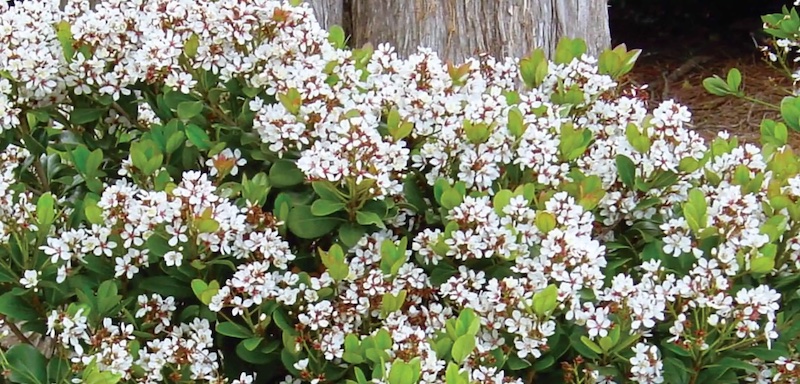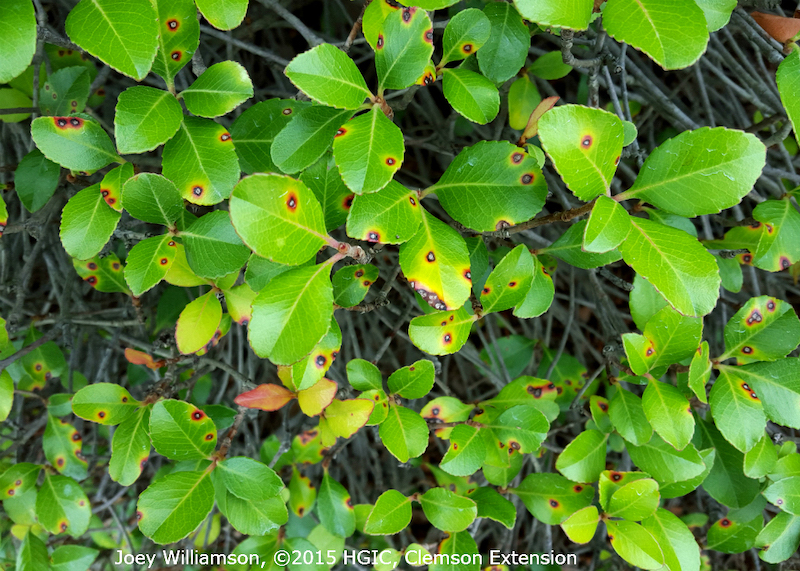Indian Hawthorn can be affected by a wide variety of bacterial and fungal diseases, although most healthy shrubs are never infected. Pathogens causing Fire Blight, Entomosporium Leaf Spot, Powdery Mildew, Verticillium Wilt and Phytophthora Root Rot are naturally present in the soil and travel in the air. They only become a problem for unhealthy or stressed plants. Providing well-draining soil with the proper pH can go a long way to keeping your Indian Hawthorn disease-free.

Fire Blight
Although Fire Blight is much more common on fruit-bearing trees such as apples, pears, and crabapples, any plant in the Rosaceae family can be infected by this highly destructive bacterial infection. The symptoms of Fire Blight appear in late spring as new growth emerges. Temperatures between 75-85 degrees F are conducive for this bacteria. Cankers that formed the previous year on stems and branches begin to ooze a liquid that can spread the pathogen to open flowers by pollinating insects or rain showers. The flowers begin to deteriorate and either produce deformed fruit or fail altogether. Once infected, the shrub remains infected until it dies.
The bacteria will move from the flowers into the bark and eventually into the vascular system of the shrub. Newly planted, young Indian Hawthorns are more susceptible than older more mature specimens. Proper planting and cultural practices will help to prevent Fire Blight.
Identifying Fire Blight
The early symptoms of Fire Blight are oozing cankers with dark streaks on stems and branches. Knotted-up bumps on the stems are cankers that form the previous year. Flowers may shrivel and die, resulting in less or no fruit, depending on the severity of the disease. Leaves will become infected, eventually turning black and falling from the shrub. This bacteria spreads faster on new growth and will eventually cause the complete death of the shrub.
Treating Fire Blight
Fire Blight is most likely to infect fresh, new growth in trees and shrubs. Managing this disease is done through both cultural and mechanical techniques. Resisting the urge to over-fertilize or over-water Indian Hawthorn is important. Plants with dense, but weak foliage growth are targets for pests and diseases. Ensure that the soil drains well and avoid overhead watering to reduce the chance of spreading the bacteria. Remove all infected plant material with pruning during the summer or winter when the bacteria are not active. Be sure to cut the damaged stems and branches far enough back to remove all signs of infection. Copper-based sprays applied early in the spring at bud break may help protect parts of shrubs not already infected, but are often ineffective against heavy outbreaks. Lastly, choosing cultivars and varieties of Indian Hawthorn that are either resistant to Fire Blight or tolerant of it is the best solution.
Entomosporium Leaf Spot
Entomosporium mespili is a fungus that causes leaf spotting and early dropping in a wide array of shrubs and other plants of the Rosaceae family. Although Indian Hawthorn is a broadleaf evergreen shrub that retains its leaves year-round, there is a period, usually in spring, when the older leaves will fall to be replaced by fresh, new growth. Massive leaf drops during other times of the year signal damage from pests or diseases. Entomosporium mespili causes leaf drop, but is rarely fatal to Indian Hawthorn. The fungus can survive year-round on evergreen shrubs and is more active during periods of warm, humid weather.
Identifying Entomosporium Leaf Spot
Small red or brown spots appear on the topsides of leaves followed by reddening of the rest of the leaf. Slowly the spots enlarge and grow together as the leaf matures. The spores will be a creamy white color that appears glossy due to the membrane protecting them.

Photo by Joey Williamson, Clemson Extension
Treating Entomosporium Leaf Spot
Avoid watering shrubs with overhead sprinklers and do not overwater your shrub. Improve drainage in the garden bed if it is slow, especially during the winter months. Remove any infected leaf litter from the garden bed. Eliminate any groundcovers where the fungus can overwinter, and avoid mulching these areas.
Powdery Mildew
The fungus that causes powdery mildew fungus is host specific and is transferred between plants by the wind and during overhead watering. The conditions that favor powdery mildew differ from other fungi and include dry, shady, and cool weather with temperatures between 60-75 degrees F. Temperatures exceeding 90 degrees and full sun exposure will kill off the fungus.
Identifying Powdery Mildew
Affected foliage will show white patches that may grow together over time. The growth may be distorted and result in yellowing or browning of infected leaves. The leaves often drop prematurely, resulting in decreased vigor and flowering in infected shrubs. Broadleaf evergreens will retain the damaged leaves much longer than deciduous plants.
Treating Powdery Mildew
The best treatment for powdery mildew is to practice good cultural habits for all plants. Plant Indian Hawthorn in a location with at least 6-8 hours of full sun exposure. Do not water with overhead sprinklers. Using drip irrigation or soaker hoses ensures that the foliage stays dry and will not spread spores between leaves or plants. Fungicides such as neem oil or copper sprays are only good at protecting healthy plant tissue and do not eradicate the fungus. Use these treatments only as a last-chance measure. Make sure your chosen product is safe to use on Indian Hawthorn shrubs. Reapplication will be needed after rainy periods.
Collar and Root Rot
Phytophthora Rot is also referred to generally by the term Collar and Root Rot. Phytophthora is present in the soil at all times. Only when the targeted plant becomes weakened or stressed does the fungus take hold. The top growth of any infected shrub will begin to slow, turn brown, wilt, and drop prematurely. The root system will stop sending out the finest root hairs that collect moisture and nutrients. Over time the root system will rot, seeming to disappear. The smaller root system will not be able to sustain the top growth, and the whole plant will eventually die.
Identifying Collar and Root Rot
Infected roots will turn brown or black, and the leaves will wilt and eventually drop. Soils that remain wet for long periods may have a strong smell to them. The base of the shrub may look like it has rotted away, sometimes exposing the inner wood and cambium of the shrub.
Treating Collar and Root Rot
Always ensure that drainage for your Indian Hawthorn is excellent year-round. Improve drainage with annual applications of organic compost as a mulch. Over time, compost improves the soil texture and helps heavy soils drain better. Do not overwater Indian Hawthorn once it is mature. This is a drought-tolerant shrub that rarely requires supplemental irrigation. Choose cultivars that are certified to be Phytophthora resistant.
Verticillium Wilt
Verticillium fungus naturally lives in soils and becomes more active during prolonged wetness and cooler spring and fall months. This fungus enters through the root system and attacks the inner tissues of plants, sometimes causing a surprisingly fast death to smaller plants like perennials and groundcovers. Broadleaf evergreen shrubs or larger trees may be able to tolerate many years of infection before dying back.
Identifying Verticillium Wilt
The symptoms of Verticillium often appear uneven or only on one side of the plant. Once the pathogen enters the plant's tissues, it causes dieback in specific parts. Foliage may lose color and eventually turn yellow or brown. Whole limbs may look droopy or wilted, while the rest of the shrub appears healthy.
Treating Verticillium Wilt
In areas where Verticillium Wilt has been a problem, only plant shrubs that have a certification of Verticillium resistance. Often this is labeled as FNV resistant. The acronym stands for Fusarium, Nematode, and Verticillium. Ensure that shrubs are watered correctly and only when needed. Overwatering can weaken plants, making them more prone to attacks from pathogens present in the soil.
Indian Hawthorn Disease Chart
|
Disease |
Identifying |
Treating |
|
Fire Blight |
Discolored, distorted, or lack of flowers; gall growths on stems that exude an infectious liquid |
Reduce spread by pruning out affected plant material during winter or summer |
|
Leaf Spot |
Dark brown or black spots on both sides of the foliage; early leaf drop |
Prune to promote air circulation; correct poor drainage |
|
Powdery Mildew |
White or silvery ‘powder’ on the tops of the leaves |
Remove infected plant material; avoid overhead watering; use a fungicide to reduce spread |
|
Collar and Root Rot |
Smaller leaves and slowed overall growth; black or dark streaking from the base of the plant; fine roots absent and larger roots dying off |
Improve drainage; plant resistant cultivars and varieties |
|
Verticillium Wilt |
Plant begins to die back in only one area, leaves and stems droop, turn brown and crispy |
Improve drainage; only buy resistant varieties and cultivars; do not replant with Indian Hawthorn |
Sources:
"Rhaphiolepis indica." The North Carolina Extension Gardener Plant Toolbox. plants.ces.ncsu.edu
"Indian Hawthorn." Clemson University Cooperative Extension Service. hgic.clemson.edu
 |
Author Robbin Small - Published 6-12-2023 |
